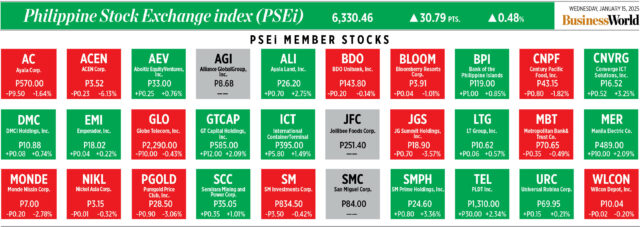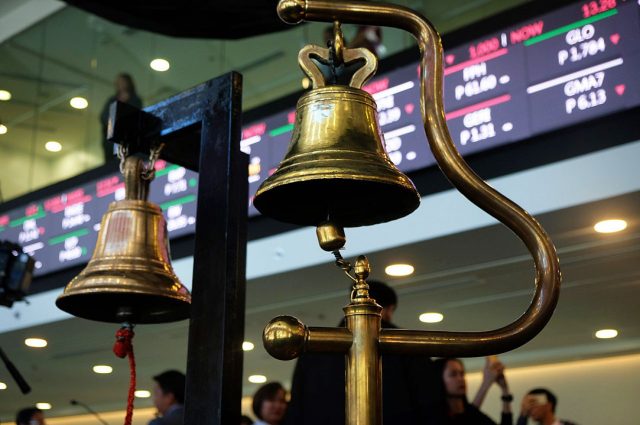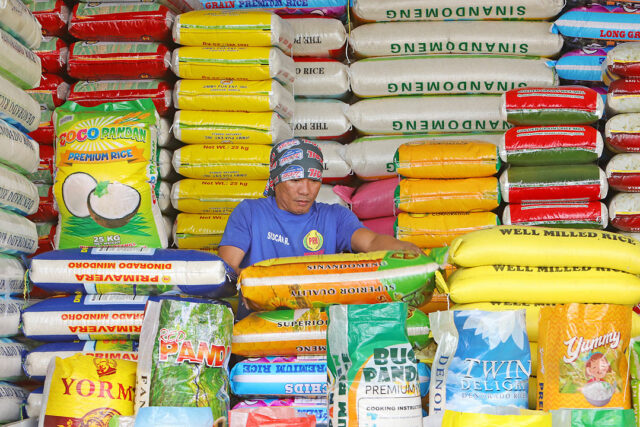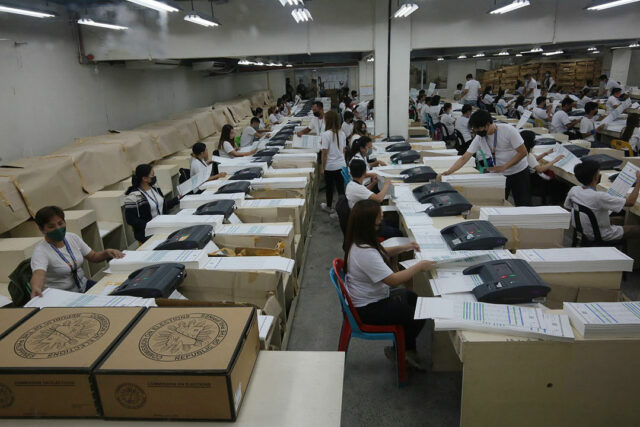Peso inches up as market’s focus turns to US consumer inflation report
THE PESO inched higher against the dollar on Wednesday as the market awaits the release of the December US consumer price index (CPI) data, which could affect the US Federal Reserve’s policy easing cycle.
The local unit closed at P58.575 per dollar on Wednesday, rising by 4.5 centavos from its P58.62 finish on Tuesday, Bankers Association of the Philippines data showed.
The peso opened Wednesday’s session slightly weaker at P58.65 against the dollar. Its intraday best was its closing level of P58.575, while its worst showing was at P58.70 versus the greenback.
Dollars traded went down to $1.37 billion on Wednesday from $1.42 billion on Tuesday.
The peso mostly traded sideways against the dollar on Wednesday as the market was cautious before the release of December US CPI data overnight, a trader said by phone.
The dollar was also weaker following a report that US President-elect Donald J. Trump administration’s planned tariffs could be implemented gradually, Rizal Commercial Banking Corp. Chief Economist Michael L. Ricafort said in a Viber message.
For Thursday, the trader sees the peso moving between P58.50 and P58.80 per dollar, while Mr. Ricafort expects it to range from P58.45 to P58.65.
The dollar’s towering rally hit a speed bump on Wednesday as traders turned cautious ahead of a closely watched US consumer inflation report due later in the day, Reuters reported.
The main market event on Wednesday will be a reading on US inflation, where investors are forecasting a 0.2% increase in core consumer prices on a monthly basis for December. Any upside surprise could further limit the scope for Federal Reserve rate cuts this year.
The greenback stabilized in the Asian session after falling overnight and edging away from a more than two-year peak hit at the start of the week. The dollar index was last 0.03% lower at 109.17.
The dollar’s decline on Tuesday came in part due to a tame reading on US producer prices, which pulled Treasury yields off their highs. — A.M.C. Sy with Reuters
Shares rise on bargain hunting after 3-day slide
PHILIPPINE SHARES rebounded on Wednesday on bargain hunting after their three-day slide and amid an improved outlook for the economy.
The Philippine Stock Exchange index rose by 0.48% or 30.79 points to end at 6,330.46 on Wednesday, while the broader all shares index dropped by 0.24% or 9.06 points to close at 3,678.80.
“Investors hunted for bargains following three straight days of decline. Helping in the market’s rise was BMI’s 6.3% economic growth projection for the Philippines this 2025,” Philstocks Financial, Inc. Senior Research Analyst Japhet Louis O. Tantiangco said in a Viber message.
“Also aiding was the record high vehicle sales in the Philippines in 2024 as per the joint report of the Chamber of Automotive Manufacturers of the Philippines, Inc. (CAMPI) and the Truck Manufacturers Association (TMA), which somehow reflects strong spending in the country,” Mr. Tantiangco added.
Fitch Solutions’ unit BMI expects Philippine gross domestic product (GDP) to expand by 6.3% this year, faster than its 2024 growth forecast of 5.8%, it said on Tuesday. The government is targeting 6-8% GDP growth this year.
Meanwhile, a CAMPI-TMA report showed that new vehicle sales jumped by 8.7% to a record-high 467,252 last year from 429,807 units in 2023. However, this missed the industry’s 2024 sales target of 468,300 by 0.2%.
“Philippine shares rebounded above the 6,300 level following the slight recovery in the global market,” Regina Capital Development Corp. Head of Sales Luis A. Limlingan said in a Viber message.
“Investors are now eyeing Wednesday’s US CPI (consumer price index) report… to assess whether inflation is nearing the Federal Reserve’s 2% target, which could prompt a shift in interest rate policy,” he added.
The Dow Jones Industrial Average rose 197.27 points or 0.47% to 42,495.92; the S&P 500 gained 17.16 points or 0.30% to 5,853.64; and the Nasdaq Composite gained 37.38 points or 0.20% to 19,125.48, Reuters reported.
US stocks received an initial lift after a Labor Department report showed the producer price index rose less than expected in December, but the report failed to sway expectations about the Federal Reserve’s likely path of monetary policy this year.
Sectoral indices were mixed. Property increased by 2.03% or 46.96 points to 2,357.70; services rose by 0.94% or 19.48 points to 2,090.86; and industrials inched up by 0.005% or 0.42 point to 8,948.84.
Meanwhile, holding firms dropped by 0.49% or 26.63 points to 5,305.33; mining and oil declined by 0.38% or 30.27 points to 7,786.23; and financials retreated by 0.09% or 2.08 points to 2,150.28.
Value turnover declined to P5.44 billion on Wednesday with 592.49 million shares traded from the P5.75 billion with 705.91 million issues exchanged on Tuesday.
Decliners beat advancers, 100 versus 88, while 44 names were unchanged.
Net foreign selling decreased to P540.58 million on Wednesday from P886.66 million on Tuesday. — R.M.D. Ochave with Reuters
Japan to sustain ODA, security aid to Philippines, says foreign minister
By John Victor D. Ordoñez, Reporter
JAPAN will continue to provide security and official development assistance (ODA) to boost Philippine maritime defenses, as the foreign ministers of both countries on Wednesday expressed concern about rising tensions in the South China Sea.
Tokyo would build on its trilateral cooperation with the Philippines and the US to maintain peace in the Indo-Pacific region, Japanese Foreign Minister Takeshi Iwaya told a news briefing during his visit to Manila.
“Japan strongly opposes any attempt to unilaterally change the status quo by force or build up tensions in the region,” he said in Japanese. “We strongly ask for easing of tensions.”
“The issue over the South China Sea is a legitimate concern for the international community because it directly links to regional peace and stability,” he added.
This comes after a virtual trilateral summit between Philippine President Ferdinand R. Marcos, Jr., outgoing US President Joseph R. Biden and Japanese Prime Minister Ishiba Shigeru this week, in which they vowed to continue cooperation in the Indo-Pacific region.
In 2016, a United Nations-backed arbitration court based in the Hague said China’s claim to nearly the entire South China Sea was illegal.
China has largely ignored the ruling, calling it void. Aside from the Philippines and China, Brunei, Malaysia, Taiwan and Vietnam also claim parts of the waterway.
“We stressed the importance of adhering to international law, especially the 1982 United Nations Convention on the Law on the Sea (UNCLOS),” Philippine Foreign Affairs Secretary Enrique A. Manalo told the same briefing.
“We will work together, leveraging our strengthened strategic partnership with other like-minded states including trilateral cooperation with the United States in preserving, upholding and defending the rules-based international order and in working for a free and open Indo-Pacific,” he added.
Mr. Iwaya was also set to meet with Mr. Marcos later on Wednesday.
The Philippine Senate in December concurred with the ratification of Manila’s reciprocal access agreement with Japan, which will ease the entry of equipment and troops for combat training and disaster response, smoothing military cooperation between Manila and Tokyo.
Japan’s National Diet has yet to approve the military pact, which both countries signed in July.
The agreement is the first of its kind to be signed by Japan in Asia and coincides with increased Chinese assertiveness in the South China Sea, where Beijing’s expansive claims conflict with those of several Southeast Asian nations.
The ratification of the pact also followed Japan’s move to provide P611 million worth of security assistance to the Philippines including radar systems, inflatable boats and other maritime equipment.
The Philippines has a visiting forces agreement with the US and Australia. Tokyo, which hosts the biggest concentration of US forces abroad, has a similar deal with Australia and Britain, and is negotiating another with France.
“As neighbors, we face similar challenges in our common pursuit of regional peace and stability,” Mr. Manalo said. “Thus, we are working together to improve resilience and enhance adaptive capacity in the face of the evolving geopolitical landscape in the Indo-Pacific region.”
The Philippine National Security Council on Tuesday accused China of intimidating Filipino fishermen near Scarborough Shoal in the South China Sea and normalizing its “illegal presence” after Beijing sent its biggest coast guard ship into the Philippines’ 200-nautical-mile (370.4 kilometers) exclusive economic zone (EEZ).
The government of Mr. Marcos has filed 199 diplomatic protests against China, according to the Department of Foreign Affairs, including one over China’s deployment of its so-called monster ship near the coast of Zambales province.
Manila’s top diplomat also floated the idea to his Japanese counterpart of a general review of the Japan-Philippines Economic Partnership Agreement (JPEPA), but did not elaborate.
Philippine Trade Undersecretary Allan B. Gepty told reporters in December Manila was pushing a review of the trade pact to include rules that would consider developments in digital trade and a more forward-looking economic deal focused on innovation and technological development.
The JPEPA is the Philippines’ first bilateral free trade agreement, which entered into force in December 2008.
Japan is the country’s third-largest export market and the third-largest source of imports. Total trade between the two reached $20.7 billion last year.
HARRIS CALL
Meanwhile, US Vice-President Kamala D. Harris on Tuesday spoke on the phone with Mr. Marcos to commit to maintaining strong bilateral ties, according to the presidential palace and the White House.
“Indeed, and I will tell you from my first visit to Manila and our first conversation, it is extremely important to me and to the United States that we reaffirm the commitment to the defense of the Philippines including the South China Sea,” the US Vice-President said, based on a statement from the presidential palace in Manila.
“I know there is bipartisan support within the United States Congress and within the US for the strength of this relationship and the enduring nature of it in terms of security, but again, prosperity and to your point of people-to-people ties,” Ms. Harris said.
Mr. Marcos told her Manila’s trilateral cooperation with Washington and Tokyo would “change the dynamics of the South China Sea and the Indo-Pacific region.”
The Philippines and China have been embroiled in repeated spats in the past few years over disputed features within Manila’s exclusive economic zone, sparking regional concerns about a miscalculation and escalation at sea.
Under President Joseph R. Biden, Washington reiterated that the treaty covers any attacks on Philippine vessels, personnel and other assets in the South China Sea and anywhere in the Pacific.
In April last year, Republican Senator Bill Hagerty and Democrat Senator Tim Kaine pushed a bill that increased US military aid to the Philippines to $500 million from $40 million over five fiscal years through 2029.
The Philippines, one of the weakest in the world in terms of military capability, is important to Washington’s efforts to push back against China, which claims the South China Sea almost in its entirety.
In a separate statement, the White House said Mr. Marcos and Ms. Harris vowed to continue cooperation between their countries on climate and clean energy, maritime security and critical minerals and semiconductor supply chains.
“The Vice-President affirmed the importance of continued defense of international rules and norms in the South China Sea in the face of provocations from the People’s Republic of China and noted the US must stand with the Philippines,” it said.
Analysts: More EDCA sites to deter Chinese encroachment

By Kenneth Christiane L. Basilio, Reporter
MANILA should consider setting up more joint military bases with Washington under their Enhanced Defense Cooperation Agreement (EDCA) as China levels up its encroachment on Philippine waters, according to security experts.
Philippine President Ferdinand R. Marcos, Jr. should reconsider his rejection of calls to create more EDCA bases, said Joshua Bernard B. Espeña, who teaches international relations at the Polytechnic University of the Philippines.
“Mr. Marcos should consider adding more EDCA sites to further enhance intelligence, surveillance and reconnaissance and force projection capabilities,” he said in a Facebook Messenger chat. “This is direly needed if Manila is serious about operationalizing the comprehensive archipelagic defense concept.”
“We must develop more EDCA sites while there is still time,” he added.
Mr. Marcos in 2023 gave the US access to four more military bases under the EDCA. These were on top of the five bases that US troops had access to.
Mr. Marcos has since said his government has no plans to open more joint military bases.
China and the Philippines have been at loggerheads over disputed features in the South China Sea, Claims the waterway almost in its entirety.
Manila has accused China’s coast guard of aggression, while Beijing is furious over what it calls repeated provocations and territorial incursions.
China is expected to ramp up its “aggression” under its sweeping South China Sea claim this year, said Raymond M. Powell, a fellow at Stanford University’s Gordian Knot Center for National Security Innovation.
Beijing asserts its sovereignty claim over the South China Sea through an armada of coast guard ships, despite a United Nations-backed court ruling in 2016 that voided its claim for being illegal.
“China’s aggression in the West Philippine Sea is likely to only increase,” Mr. Powell said via Messenger chat. “It has shown both the will and capability to push its sovereignty claims.
The Chinese Embassy in Manila did not immediately reply to a Viber message seeking comment.
The sea dispute between the Philippines and China started escalating in 2012 after a standoff at Scarborough Shoal, but tensions boiled as early as the 1990s when Beijing and Manila were engaged in a naval skirmish at Mischief Reef, according to US think-tank Council on Foreign Relations. The reef is just 250 kilometers off the major Philippine island of Palawan.
Beijing would likely escalate its claim through “swarming methods” while leveraging diplomatic tactics and propaganda to strengthen its hold and legitimize its claim in the waterway, Mr. Espeña said.
MORE SHIPS
Setting up more joint bases with the US could result in “new airstrips, berthing areas, ports and logistic centers to sustain operations and cover the large swathe of the South China Sea,” he added.
“At the strategic level, this may provide the Philippines with a thicker shield to defend itself and a sharper sword to draw against China,” he said.
But efforts to increase EDCA military bases should not be communicated in a manner that would antagonize China, said Chester B. Cabalza, founding president of Manila-based International Development and Security Cooperation.
Instead, the bases should be a means to enhance interoperability between US and Philippine forces for the sake of “peace and order in the region,” he said via Messenger chat. “Otherwise, China will retaliate against our hawkish anti-Chinese defense policy. And it will become a vicious cycle of vengeful attitudes toward each other.”
Philippine authorities should also empower the Philippine Navy and Philippine Coast Guard to boost their presence in the South China Sea, said Don Mclain Gill, an international studies lecturer at De La Salle University in Manila.
“Maritime law enforcement agencies such as the Philippine Coast Guard (PCG) and Navy [need to be supported so they could] actually monitor and enforce our maritime space,” he said in a voice message via Facebook Messenger.
Manila should acquire more ships to increase sea patrols within the country’s exclusive economic zone, he added.
The PCG is set to acquire 49 new ships from France and Japan by 2027, Commandant Ronnie Gil L. Gavan said last year. Two corvette warships and six offshore patrol programs are in the pipeline for the Navy acquisition, Rear Admiral Roy Vincent T. Trinidad said last month.
“That would allow us to increase our patrols within our exclusive economic zone,” Mr. Gill said.
The Philippine government should “mix and match” its defense capabilities to better project deterrence, such as buying missile systems and investing in “asymmetric technologies,” he added.
Frequent joint patrols and exercises with allies in “key flashpoint” areas are also needed to bolster Philippine presence in the South China Sea, a key conduit for $3 trillion of annual ship-borne trade, Mr. Gill said.
US President-elect Donald John J. Trump might be interested in consolidating forces in the South China Sea via the Philippines given his tough stance against Beijing and the assembly of China hawks in his cabinet, Mr. Espeña said.
Marcos restores tourism marketing budget
PRESIDENT Ferdinand R. Marcos, Jr. on Wednesday ordered the Department of Budget and Management to use P400 million from his office’s contingency budget to fund the Department of Tourism’s (DoT) marketing campaigns this year, citing the need to boost the industry, according to the Presidential Communications Office.
“Restore the P400-million branding budget of DoT to sustain the momentum,” he said during a meeting with Tourism Secretary Ma. Christina G. Frasco, based on a statement from the presidential palace.
The President said the Philippines should not lose the momentum in promoting tourism programs to boost the country’s image and attract more foreign visitors.
Mr. Marcos earlier approved a proposal from his private sector advisers for a nationwide shopping festival and to ease visa access to foreigners, according to the palace.
In December, he signed into law a measure allowing foreign tourists to claim value-added tax for purchases worth at least P3,000. This is expected to boost tourist spending by at least 30% and benefit mostly micro, small and medium enterprises.
Based on Tourism data, the Philippines earned about P760 billion from international visitor receipts last year.
The Philippines received 5.95 million international visitors in 2024, up 9.15% but below the 7.7-million target. — John Victor D. Ordoñez
PhilHealth told to fix system for hospital reimbursements
THE Philippine Health Insurance Corp. (PhilHealth) should improve its reimbursement claims system for hospitals to prevent their closure from financial strain due to unremitted payments, a legislator said on Wednesday.
The state health insurer owes hospitals about P21 billion as of end-2024, PhilHealth Senior Vice-President Renato L. Limsiaco, Jr. told lawmakers during a House of Representatives hearing.
“PhilHealth’s so strict in denying claims that we’re squeezing the liquidity of hospitals, which in the end, forces them to close,” Marikina Rep. Stella Luz A. Quimbo said in Filipino at the same hearing.
Philippine hospitals file reimbursement claims to PhilHealth for the accrued costs of medical services provided to Filipinos, which is then deliberated by the state health insurer to determine its validity for compensation.
Processed claims which PhilHealth finds worthy of repayment are tagged as a “good claim,” according to a 2021 PhilHealth memorandum; while reimbursement requests seen as “deficient” are categorized into return-to-hospital (RTH) and denied claims, which leads to it being unpaid.
Most denied PhilHealth claims are due to the 60-day deadline limit for the filing of reimbursement requests, Department of Health (DoH) spokesman Albert Francis E. Domingo told lawmakers.
He said the Health department proposed to the PhilHealth board to extend the 60-day limit, allowing “denied claims to become good claims.”
“The Department of Health found that most of the denied claims were due to exceeding the 60-day deadline stipulated by law. However,… it was noted that the 60-day period may be extended due to reasonable reasons,” he said in mixed English and Filipino.
PhilHealth Chief Executive Officer Emmanuel R. Ledesma, Jr. said his agency would implement an “opinion” from the Office of the Government Corporate Counsel (OGCC) allowing them to pay hospitals if hospital claims are filed within 60 days.
“We just got the opinion from OGCC. So, we’re about to implement it,” he said.
PhilHealth has denied a total 483,000 claims from hospitals, totaling P4.7 billion for 2024 alone, according to Mr. Limsiaco.
“If we’re going to look into the RTH… for the year 2024, [it] reached 304,082, amounting to P4.2 billion,” he added. — Kenneth Christiane L. Basilio
House speaker meets with Hungarian MPs to advance bilateral ties

HOUSE of Representatives Speaker Ferdinand Martin G. Romualdez on Wednesday met with parliamentarians from Hungary, discussing “opportunities” for advancing bilateral relations.
In a statement, Mr. Romualdez said he met with Zsolt Attila Németh, foreign affairs chairman of Hungary’s parliament, and his delegation.
“It is a pleasure to meet Chairman Zsolt Németh and discuss the numerous opportunities to strengthen our partnership. Hungary has been a steadfast friend to the Philippines, and I look forward to further deepening our cooperation in the years to come,” he said in a statement.
“These visits reflect the strong diplomatic ties and mutual respect between our nations,” he added.
Mr. Németh said he’s optimistic that a Philippine-European Union free trade agreement (FTA) could be finalized this year, according to the statement. “Scoping meetings” for the FTA started in 2013, according to the Philippine Trade ministry.
The Hungarian lawmaker also proposed a possible conduct of joint training exercises between the two countries’ workforce, citing “high standard of work ethic” of Filipinos.
A “Philippines-Hungary Parliamentarians’ Friendship Group” between the two countries’ legislative chambers would also be established after the 2025 midterm elections, according to Mr. Romualdez. — Kenneth Christiane L. Basilio
Max SRP on all rice products eyed
THE Department of Agriculture (DA) is looking at expanding a proposed maximum suggested retail price (MSRP) for all rice varieties in a bid to lower rice prices quicker.
But it will first assess how the initial proposed MSRP for imported rice would play out before implementing a wider peak retail price on the staple food, Agriculture Undersecretary Asis G. Perez said on Wednesday.
The DA had set the MSRP at P58 per kilogram for imported rice with broken-grain content of 5%. The price ceiling is expected to take effect on Jan. 20, initially in Metro Manila.
“That’s being considered,” Mr. Perez said when he was asked by lawmakers about the possibility of broadening the rice cap.
“We started at P58 because we didn’t have prior experience,” he added. “Since this is like a pilot, we wanted to look at it and then analyze further how we can improve. But that’s part of the strategy.”
The Agriculture department noticed that retail prices for some imported rice brands remain elevated despite lower import tariffs.
President Ferdinand R. Marcos, Jr. last year issued Executive Order No. 62 which slashed tariffs on rice imports to 15% from 35% previously until 2028.
The DA is also looking at possibly implementing a price cap for rice products if it finds the retail market prices to be “unreasonable,” according to Mr. Perez. “We’re even considering a price cap itself.”
In December, the Philippine Statistics Authority reported an average price for well-milled rice of P54.97 per kilo.
“However, right now, we’re not doing that yet. We only used what we call the suggested retail price,” he said.
Mr. Perez said they implemented an MSRP in the hopes of sparking a trickle-down effect on persistently expensive rice prices.
“The theory is, if there’s a cap on premium [rice], regular mills will follow,” he said.
Employing a MSRP for imported, premium rice could lead to cheaper rice, said Steven T. Cua, executive director of the Philippine Amalgamated Supermarkets Association, supporting DA’s assertions.
“If the DA will come up with a statement saying that P58 for premium, I think everything below will go down,” he said.
Meanwhile, the National Price Coordinating Council is also looking at declaring that there is an “extraordinary increase” in rice prices, which would allow the Agriculture secretary to proclaim a food security emergency, said Cherryl G. Carbonel, a Department of Trade and Industry director.
“But we’re still working on the resolution,” she told lawmakers.
A food emergency declaration would allow Agriculture Secretary Francisco P. Tiu Laurel, Jr. to release rice stocks held by the National Food Authority (NFA), which would increase the market supply of the staple food in a bid to bring down its retail prices.
Also on Wednesday, NFA Administrator Larry R. Lacson said they are looking to sell aging rice buffer stocks at P33 to P38 [per kilo] to local government units.
“Our current stocks at the NFA total around 700,000 bags of milled rice. Out of those, 300,000 can be considered aging or non-regular stocks,” he told lawmakers. — Kenneth Christiane L. Basilio
Computerization fund falls short

AN EDUCATION department official on Wednesday said the 2025 funding allotted for the Department of Education’s (DepEd) computerization program is insufficient.
“The present allocation of P2.4 billion would not even enable the DepEd to handle the mandatory need [for its computerization program], which amounts to P3.9 billion,” Marvin Dela Cruz, DepEd’s Technology Infrastructure Division chief, told lawmakers during a House of Representatives hearing.
It would cost the Education department P3.9 billion to fund “software and cloud subscription for all teachers and learners, capacity-building, [and] operation and personal expenses,” he added.
The Philippines Congress decided to cut DepEd’s computerization program fund for 2025 by about P10 billion, slashing it by 80.3% to P2.43 billion, according to Budget department documents.
The originally proposed P12 billion funding for this year would’ve been used to buy laptops and smart televisions (P7 billion), satellite-based internet devices (P1.5 billion), software subscriptions (P2.4 billion), and capacity-building purposes (P1.5 billion), according to DepEd’s presentation to the House basic education panel.
About P2.45 billion worth of laptops and smart televisions are now in the final process of procurement as of Jan. 13, owing to the agency’s “strategic use of early procurement activities,” the presentation stated.
“This alone would eat up the P2.4 billion appropriated for the whole ICT (information and communications technology) budget of the DepEd,” it added. — Kenneth Christiane L. Basilio
Calamity fund releases hit P24B
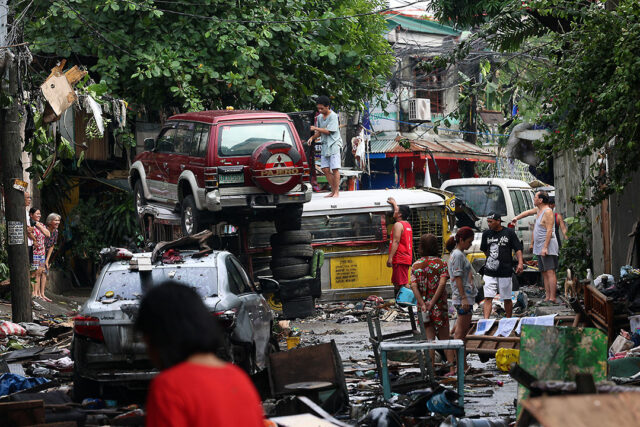
THE Department of Budget and Management (DBM) on Tuesday reported that it has released P24.36 billion in calamity funds, as of end-December 2024.
According to its latest National Disaster Risk Reduction and Management Fund (NDRRMF) status update, P22.08 billion has been released to state agencies, while P520.14 million was allocated to government-owned and -controlled corporations.
The Department of Public Works and Highways received P12.09 billion while the Department of Social Welfare and Development got P8.14 billion.
Meanwhile, P374.97 million was given to the Department of Human Settlements and Urban Development, P557.34 million to the Department of Finance, and P345.16 million to the Department of National Defense.
Moreover, P450 million was released to the National Irrigation Authority, P50 million to the National Housing Authority, and P20.20 million to the Local Water Utilities Administration.
The DBM has yet to release P136 million out of this year’s P22.74-billion NDRRMF budget. — Aubrey Rose A. Inosante
Comelec may resume ballot printing on Monday
THE Commission on Elections (Comelec) said it aims to resume reprinting ballots for the midterm polls on Monday, after the Supreme Court (SC) ordered the inclusion of five previously disqualified political aspirants in the ballots.
Chairman George Erwin M. Garcia, in a virtual briefing on Wednesday, said updated ballot faces featuring the names of the five candidates could be available by Sunday, Jan. 19.
He added that once these new faces are uploaded on the Comelec website, it signals the poll body’s readiness to resume ballot reprinting.
“This is the first time in our electoral history that the Comelec will order a reprinting, back to zero, of the ballots in compliance with the order of our Supreme Court,” he said in mixed English and Filipino.
About 6 million ballots for the national positions were wasted. Each ballot costs about P22, Mr. Garcia noted.
The poll body has yet to start printing local position ballots. “There’s no problem with the local positions since the ballots have not yet been printed,” he noted.
This comes after the high tribunal in full court issued five TROs against the poll body on Tuesday, allowing the names of five bets to be included in the ballots after Comelec barred them last year from participating in the upcoming national and local elections on May 12.
One of them is a senatorial aspirant and Moro leader, Subair Guinthum Mustapha.
The rest are gunning for local seats: three are eyeing seats in the House of Representatives and one for a gubernatorial position.
Before the poll body resumes its printing, Spokesman John Rex C. Laudiangco told BusinessWorld through Viber that they would first finish the changes in the candidates’ database, electronic management system, automated counting machines, consolidated canvassing system, online and voting counting system, and when they have uploaded the ballot face templates after generation and serialization.
Following this, they would also appeal to the Commission on Audit to have the 6 million ballots shredded to prevent them from being used in the actual election.
Despite the setback, Mr. Garcia said the election will go on as planned on May 12 as “they are in control of the situation.”
The Philippines will hold a midterm election next year. Filipinos will elect their congressmen, mayors, vice-mayors and members of city councils on May 12, 2025. Twelve of the 24-member Senate will also be replaced. — Chloe Mari A. Hufana

